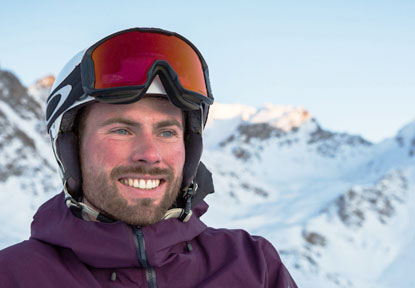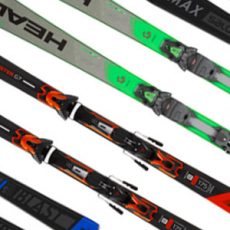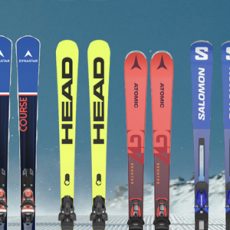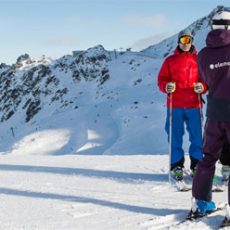GET THE LOW-DOWN ON NEXT SEASON’S KIT
We talked to BASI Trainer Will about what kit to look for if you’re training for the BASI 3 or 4 next season.
Not only does Will train instructors, his family have ski shop. So he’s in the perfect place to advise you…
It may only be August, but for those of you who are already itching to dust off the ski boots and get back to the mountains, here are our latest thoughts on the best skis and boots for the BASI level 3 and level 4.
If you want to take your training seriously and make real progress next winter, then there are a few things you can start to take control of now. Get yourself on a fitness training programme being the number one priority, this one takes time and bagging a few months of consistency with this is super valuable. However, you should also be lining up your equipment.
You don’t want to get caught out in the last minute rush before you head out to the mountains, unable to find stock of the skis or boots you need. The gear you’re buying is very specific and the ski manufacturers don’t sell that much of it.
These days there is far less spare stock sitting around, so get your orders in as early as possible to ensure you do get the gear you need.
Having the right skis and boots on your feet from day one, week one of your training is very important. If you’re committing to a training block of any kind, sorting the right equipment is not going to be your biggest expense, but it will make the difference on the mountain.
It is very common that trainees turn up on old kit hoping that it will get them through. They proceed to waste many weeks of training while they try and source some new skis or boots…
In this blog I will provide my thoughts on the best skis and boots for the BASI ISIA and ISTD. This is based on my own experience testing skis, coaching and examining on BASI exams over the past few years. This is just my view of the best options out there, of course other options do exist.
SKI BOOTS
You should already know this by now, but please don’t just buy a stiff race boot off the internet and hope it will fit.
Take a trip to a good boot fitter and let them help you find the right fit. The first golden rule here is, do not buy a freeride boot! If it has a walk mode, say no. Even if it has the right flex rating, say no. These boots are not suitable for piste performance, as they’re too upright and they’re made of lightweight plastic which does not flex well.
Aim for a boot which is either a stiff piste performance boot or an off-the-shelf race boot (not a plug boot).
If you’re a woman you’re going to be looking for something between 100 and 120 flex and guys will be looking for 110 to 130. This is a rough guide, but no one should need to go above 130 unless they are very heavy and/or tall.
As a bit of a guide as to the models you might come across at the boot fitters, the following are some good options:
Lange
RS range
Off-the-shelf race boot, not super stiff but also have the advantage of a narrow or wide option. They also have the Shadow range which is a slightly toned down version, these will be fine if you’re on your level 3.
Rossignol
They make exactly the same boot as the RS as the parent company are the same, their version is called the Hero.
Head
Raptor range
These seem to come out pretty stiff compared to other brands, so err on the side of caution with the flex rating.
Tecnica
Firebird
Good for very narrow feet, even the wider option is still pretty narrow.
Nordica
Doberman
Very similar to the Firebird above.
You can dictate the flex rating and type of boot to the boot fitter, but they can guide you to the right brand/model which will fit your foot the best.
Now, let’s talk about skis.
SKIS
It can feel like there are too many choices and it can be hard to see the wood through the trees, so let’s try and simplify it.
The first thing is to look for skis of the correct radius within the on piste category. Aim for something between 13m and 16m.
Some people like to ski a radius slightly longer than that, but I think for most people it can make things a little more challenging, especially as they also tend to be longer in length.
Once you have found a ski with a radius you’re happy with, then check that the length is appropriate for you in that radius. With most skis, the radius increases as the length increases, so check the length and radius combination works for you. Aim for something around chin to head height.
Then you need to check the width underfoot, don’t go for anything wider than 70mm underfoot. As you go towards the narrowest race orientated skis, which can be as narrow as 65mm, they will be a little more difficult in soft snow and variables, so be aware of that.
Finally, you need to make a judgement on the stiffness of the ski by looking at the construction. If the construction indicates there are full layers of some form of metal (lot’s of different jargon used, Titanal is the most common), then the ski will be stiffer.
A stiffer ski is not always better, if you buy a ski which doesn’t flex easily, they can be very unforgiving. If you do not manage the pressure build up correctly or you lack fore-aft balance, you will get punished more by a stiffer ski.
However, a stiff ski will provide you with better edge grip on firmer snow and when skiing faster on steeper terrain. These are things you will have to tackle more as you move up to level 3 and particularly to level 4. So you do need to step things up from the skis you probably used for the BASI Level 1 and Level 2.
I have outlined some recommendations below, which keep you within the right flex range for the level 3 and 4. All of them have the appropriate radius and width underfoot.

OPTIONS FOR NEW LEVEL 3 TRAINEES
If you’re new to level 3 training, it can be good to start on something a little more forgiving rather than jumping straight onto a super stiff ski.
This will allow you to more easily work on the fundamental movements and skills required for that step up to level 3 and beyond. At slower speeds these skis will be a little easier, but they’re also going to be fine all the way through to the level 3 exam.
Be aware that skis lose their life over time. After a full season on a set of piste skis, it will be very
noticeable how much softer they feel. If you already happen to have a set of these skis from your level 2, it would still be worth getting a fresh set ahead of level 3 training.
Some good examples include the Head e-Magnum, the Salomon X/Max 12, or the Dynastar Speed 963. Dynastar and Head both offer women’s specific versions too, called the Dynastar E-Lite 9 and Head Super Joy.
Taking a new set of these into level 3 will work for most people, however some heavier people may find them a little soft and may want to look at the options below.

OPTIONS FOR ESTABLISHED LEVEL 3 TRAINEES OR NEW LEVEL 4 TRAINEES
If you looking for something a little sturdier as a seasoned level 3 trainee or if you’re moving on to start level 4 training, then these options are my top choices.
It is worth pointing out that a lot of these skis sit just under the race department skis and tend to be unisex.
My favoured choice here is Head World Cup Rebel E-Race or E-Speed. The E-Race is most popular as it has a slightly shorter radius, then there is the E-Speed if you fancy something a little straighter. Avoid the ‘Pro’ versions if you’re in this category.
They have a really nice balance to them, stiff enough for the piste performance but forgiving enough to make the bumps are variables manageable.

The Salomon S/Race GS 10 and 12 are also great choices and previous trainees have enjoyed these. They look great for starters, and you have the choice of the 10 if you want something softer or the 12 if you’re looking for max sturdiness.

Finally, the Atomic G7 is a nice ski which hits the mark for level 3, probably a little soft for anyone starting level 4. The only word of warning here is that they have been known to break more easily than other brands. Usually you’ll get a replacement set in these cases, but be warned.

OPTIONS FOR LEVEL 4 TRAINEES
Finally, for the those in the midst of level 4 training, you know the score by now. There aren’t loads of options as not all brands produce something that aligns well with requirements we have for BASI exams.
You have probably got quite a good idea of what you need now, or perhaps you’ve had a bad experience with a certain ski and looking for something a bit different. Sometimes it does takes a few seasons to find something you really get on with.
For me, as someone who is 5’10 and about 75kgs, I think the sweet spot is a 175cm, 16-18m radius. I really rate the E-Race Pro as it feels nice and stiff under the foot so it holds really well on firm snow. But it also has enough flex along the length of the ski which makes bumps and variables manageable on them.
The E-Speed Pro is now a very different ski to what it was, so I don’t think it is very well suited to BASI exam skiing. It is very narrow and straight, with the radius creeping above 19m. I think it is a tough ski in all the strands, so I’d stick with the E-Race Pro.

If you like a longer ski but with a short radius, then the Fischer RC4 Pro is an option to consider. I know a few coaches who have been enjoying these, so they’re well worth a look.

The Dynastar Master GS Konect is probably the best best if you’re looking for something more towards an 18m radius which is pretty stiff. A lot of people struggle with how stiff they are, so they’re not for everyone. The Konect version is a softer version as it doesn’t have a race plate, but it is still fairly full on.

Unchanged from last year, the Atomic G9 is worth a look, but it does suffer from some of the reliability issues that I mentioned above. Nonetheless, a ski which lot’s of people have passed on and Atomic do very well on the ski racing circuit, so they must be doing something right!

There are good options out there but I know less about these, check out brands such as Salomon, Blizzard and Nordica.
If you’re looking for more in depth advice and generous BASI discounts on gear, don’t hesitate to get in touch with our partners, Fluid Lines. Fluid Lines have four BASI level 4’s and three BASI trainers on the team, so they are very well placed to advise you!
Once you’re kitted out, the next step is to organise your training, please do not hesitate to get in touch if you want to discuss training for your level 3 or 4 with us in Verbier this winter!




